
Home - Search - Browse - Alphabetic Index: 0- 1- 2- 3- 4- 5- 6- 7- 8- 9
A- B- C- D- E- F- G- H- I- J- K- L- M- N- O- P- Q- R- S- T- U- V- W- X- Y- Z
Kliper
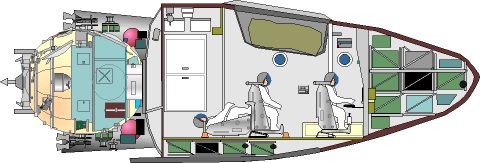
Kliper
Cutaway view of 2005 winged version of Kliper
Credit: © Mark Wade
AKA: Clipper. Status: Study 2004. Payload: 500 kg (1,100 lb). Gross mass: 12,500 kg (27,500 lb). Height: 12.00 m (39.00 ft). Diameter: 3.90 m (12.70 ft). Span: 8.00 m (26.20 ft).
Through the next four years several versions of the design were produced in an attempt to satisfy Russian and European Space Agency requirements and objections. By 2008, a simpler ballistic design was preferred as having lower mass and less risk.
The 2004 Kliper was a 14.5 metric ton reusable lifting body that could be used as a space station ferry and lifeboat, or operate independently to shuttle tourists to space. RKK Energia had begun the work on the design in 2000, at the request of the Russian Space Agency. Energia had already studied a new manned spacecraft concept in the 1990's, envisioned for launch on the Angara or Zenit launch vehicles.
This design had a truly unique configuration. Unlike virtually every other manned spaceplane ever proposed, the crew would be seated with their backs to the nose of the glider and the glider mounted nose-down on the launch vehicle. Assuming a completely autonomous landing system, this actually made sense from the standpoint of crew physiology. It also solved the problem of docking the re-entry vehicle since the standard androgynous docking system was located at the forward end of the spacecraft and could have been recovered for reuse.
By the 2004 announcement, the Kliper configuration followed a more conventional, and less reusable solution. Docking systems were moved to a jettisonable BO orbital module derived from that of Soyuz. The glider was mounted nose to the sky, without a docking system, on the booster. Permanent lugs for the mounting of an SAS abort tower were located on the nose of the spaceplane.
Key features of the 2004 Kliper were:
- Missions: Delivery of crews and cargo to space stations and their return to earth; space station lifeboat; autonomous missions to orbit for space research or tourism
- Launch mass: 14.5 metric tons. Payload: two pilots, up to four passengers, up to 700 kg cargo. Landing mass: 9.5 to 10.0 metric tons.
- Launch vehicle: The Onega, a hitherto-unrevealed massive improvement of the reliable Soyuz-U. In order to achieve a payload double that of the current vehicle, it would seem a high-energy Lox/LH2 upper stage would be needed. Such an improvement was proposed as far back as July 1962 (the Molniya 8K78L) but never developed.
- Launch sites: An existing pad at Baikonur would be modified initially. A pad at Plesetsk, or the new Soyuz pad at Kourou could be modified eventually to accommodate the Onega.
The spacecraft consisted of three major modules:
- The SAS abort tower. Permanent lugs for the mounting of this were located on the nose of the spaceplane
- The reusable re-entry vehicle. The crew entered through a hatch aft, in the base of the glider, and were seated in two seats in the first row for the pilot and co-pilot, and three seats in the second row for the passengers. There was space behind the second row for payload for a fourth passenger in an emergency. The RV had a total mass of 9800 kg and had a 'flatiron' configuration similar to the American Asset configuration of the 1960's. The Kliper lifting body was said to be capable of a cross-range of 1,000 km during which the forces on the crew would not exceed 2 G's and the maximum stagnation temperature would be 3000 deg K. Final landing was accomplished by a parasail system. Automatic guidance would glide the spacecraft to a thump-down on land to within 1 km of the aim point. The RV was capable of 25 reuses without substantial refurbishment.
- The expendable PAO service module. This essentially consisted of a Soyuz orbital module mounted within a cylindrical fairing. The modified Soyuz BO orbital module provided the usual living quarters and universal docking collar and system for use with the ISS. Arranged around the orbital module were the propellant tanks of the main and RCS propulsion systems, oxygen and water for up to ten days of autonomous operations in orbit, and lower-value electrical and avionics systems. Mounted on the top of the service module were solar panels to provide electricity. The service module would have a total mass of 4700 kg.
The Kliper seemed to be derived from work done in Russia in the 1990's on a range of lifting-body manned recovery solutions. These included the Russian Air Force's Tsiolkovskiy institute's VKK configuration that was to be launched by Zenit-2 but owed something to Chelomei's Kosmoplan and Raketoplan designs of the 1960's. Kliper itself harked back to Energia's MTKVA 'Glushkolyot' pre-Buran design and the Mars 1986 lander. All of these solutions affirmed the bureau's long and abiding preference for manned semi-ballistic re-entry vehicles with parachute landings (as opposed to winged solutions with runway landings).
By August 2005, Kliper had been completely revised. It now featured a stubby delta-winged re-entry vehicle, which resulted in better cross-range, but a 500 kg higher mass and 200 kg less payload. The Russian government was however unable to provide the 10 billion rubles of financing needed for Kliper. In the face of uncertainties regarding NASA's future ability to deliver crews to the International Space Station, the Russians were in talks with the Europeans on co-development.
Three alternate launch vehicles were now considered for use with the 15-metric ton payload, with Kourou now the primary launch site due to the hoped-for European involvement. It now included lunar and deep-space missions, presumably to provide a European counterpart to the American CEV that could fly a variety of missions through most of the 21st Century.
Key features of the 2005 version of Kliper were:
- Missions: Delivery of crews and cargo to space stations and their return to earth; space station lifeboat; autonomous missions to orbit for space research or tourism; lunar orbital missions. Maximum mission duration five days with full crew and payload.
- Launch mass: 15.0 metric tons. Payload: two pilots, four passengers, 500 kg cargo. Landing mass: over 10 metric tons. Return payload: 300 kg.
- Launch vehicle:
- The Onega, now also dubbed the Soyuz-3.
- The Zenit-2SLB, an improved version of the Zenit-2, upping payload from 13.7 metric tons to 15.0 metric tons. Based on the drawing provided, this was accomplished by stretching the booster's first stage.
- The Angara 3A, a proposed variant of the modular launch vehicle under desultory development in Russia. This would use two universal rocket modules (URM's) as boosters flanking one URM in the core, with a Lox/Kerosene upper stage. This was previously-announced as having a nominal 14 metric ton payload mass to a 200 km/63 degree orbit.
- Launch sites: The new Soyuz pad at Kourou would be modified to accommodate the Onega.
The spacecraft consisted of three major modules:
- The reusable re-entry vehicle. This was now a stubby delta-wing glider, with a 1500 km cross range. The Sukhoi design bureau was brought into the project to provide expertise on the aeronautical design. The crew entered through a hatch in the side of the glider, and were seated in two rows of three seats each. The design was now capable of a runway landing, but still featured a parachute system, evidently for use in an emergency.
- The expendable PAO service module. This again consisted of a Soyuz orbital module, now mounted within a flared fairing.
- A launch fairing, on which were mounted solid rocket motors that would push the glider away from the launch vehicle in an emergency. This took the place of the abort tower on the original design.
Logically the Kliper would be launched by the Russian Angara booster, supposedly still in development by Khrunichev. The proposal for the Onega booster would seem to be a bid to reopen the competition, by proposing a 'lower cost' launch vehicle using proven R-7 technology.
By 2006 RSC Energia had modified the Kliper design twice more, moving toward total reusability by using the Parom tug for interorbital maneuvering. Energia, the Sukhoi Aviation Holding Company, the Central Civil Aviation Institute, Central Research Institute of Machine-building, Progress Samara Space Center, Design Bureau of General Engineering (KBOM) and others had joined to collaborate in Kliper development.
The midterm Kliper design had a total mass of 14,000 kg and consisted of:
- A re-entry vehicle (RV), 9200 kg. This consisted of a hypersonic glider and a removable pressurized cylindrical cabin module that would slide into the glider from the rear. The version of the cabin module for crew transport would consist of three rows of two crew seats.
- A service-habitation module (SHM), 4800 kg. This included a propulsion system used to rendezvous and dock with the ISS. After departure from the station, the module provided retrofire to return the glider to earth, and was then separated and burns up in the atmosphere.
- An emergency recovery system (ERS) module, 3300 kg. This would provide propulsion for final ascent of the spacecraft into orbit if required; and emergency recovery of the crew in the event of launch vehicle failure.
By the May 2006 design iteration it was decided to obtain complete reusability of the Kliper spacecraft. The Parom interorbital tug would be used to take Kliper from a low insertion orbit to the ISS. The revised spacecraft consisted of the 9200 kg RV with the cabin module and a 3300 kg propulsion module (PM), which replaced the ERS module. The PM would power the final ascent of the spacecraft into orbit; brake the spacecraft for return to the Earth; and provide emergency recovery of the crew during launch aborts.
Kliper would be placed into orbit via the Soyuz-2-3 launch vehicle being studied by the Progress Samara Space Center. If funding could be obtained, the first unmanned test flight of Kliper was planned for 2013 and the first test manned flight for 2014. Five Kliper spacecraft would provide shuttle service to the ISS from 2016.
In addition to six crew, Kliper could deliver or return 500 kg of payload from the ISS. It was designed for up to five days of autonomous flight, and on-orbit storage of up to 360 days when docked with the ISS. The crew would be subjected to a maximum of 2.5G's during reentry. The glider would have a cross-range capability of 1200 km and be capable of landing at a conventional airfield. Each reusable glider would be designed for 60 missions over a 15 year life.
Variations of the design were revisited yet again in 2008 in response to the Russian Space Agency's next-generation manned spacecraft solicitation. Three versions were proposed, slightly different from those studied earlier. All variants had to meet the following requirements:
- Crew of six with 500 kg of payload; or two with 1,000 kg of internal payload
- Capable of 14 days of autonomous flight with full crew, and one year of on-orbit storage when docked to a space station
- Provisions for crew rescue from the moment of launch to recovery. This meant an abort tower for the early launch phase, and a reserve parachute for recovery, but not ejection seats or orbital bail-out pods.
- Designed probability of returning the crew safely to earth of 99.9%
- Minimal preparation time to allow prompt evacuation of crew members to earth in medical emergencies
- Maximum G-forces in a launch abort of 14 G's, 5 G's during normal ascent to and return from orbit, and 12 G's during an emergency ballistic reentry
- Normal launch and recovery from the territory of Russia (this would require launch from the new Vostochniy Cosmodrome instead of Baikonur).
- Minimal development and production cost
- Operational no later than 2018
- Production life 30 to 40 years
- Landing accuracy of less than 15 km from aim point
- At least 2 cubic meters habitable volume per crew member (e.g. 12 cubic meters habitable volume total)
- Environmentally safe propellants (e.g. not nitrogen tetroxide/hydrazine, but rather oxygen/kerosene or similar)
- No debris left in orbit after mission
- Low cross-range / parachute landing version. This wingless lifting body, a version of the 2004 Kliper, had a spacecraft mass of 15 metric tons and a BDAS mass of 5400 kilograms. It would subject the crew to 2.5 G's during ascent, 8.5 G's in a launch abort, and 5 G's on a standard re-entry. Cross range would be 500 km, and range along the orbital track could be extended to 6000 km from the ballistic landing point. This maneuverability would allow the spacecraft to land on Russian territory on 3 to 4 orbits a day, descending under parachutes within 11 km of the aim point. 80% of the spacecraft could be reused.
- Low cross-range / winged landing version. This had low-aspect ratio wings that folded up along the side of the spacecraft during ascent and re-entry, deploying only at subsonic speeds to allow Kliper to glide to a runway landing. Spacecraft mass increased to 16 metric tons and BDAS mass to 5500 kg. This version would subject the crew to 2.5 G's during ascent, 8.5 G's in a launch abort, and 1 to 2 G's on a standard re-entry. Cross range would be the same as the low cross-range version. However the wings would allow the spacecraft to make a precision gliding landing at an airfield and land on Russian territory on 7 orbits a day. The spacecraft would be essentially completely reusable.
- High cross-range version. This had fixed delta wings similar to the American Dyna-Soar of the 1960's. Spacecraft mass again increased to 17 metric tons and BDAS to 5700 kg. It would subject the crew to 2.5 G's during ascent, 6.5 G's in a launch abort, and 1 to 2 G's on a standard re-entry. Cross range would be 1200 km, and range along the orbital track could be extended to 13,000 km from the ballistic landing point. This maneuverability would allow the reusable spacecraft to land at an airfield on Russian territory on 9 orbits a day.
Special thanks to Dietrich Haeseler, Ed Grondine, Anatoly Zak, Vojko Kogej, and Joachim Wienecke for contributing information and images to this article.
Crew Size: 6. Habitable Volume: 20.00 m3.
Family: New Generation Crewed, Space station orbit, Spaceplane. Country: Russia. Launch Vehicles: R-7, Onega. Agency: Korolev bureau, RAKA. Bibliography: 587.
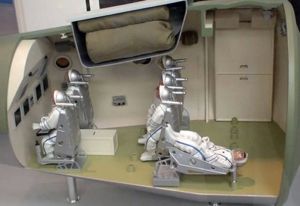 | Kliper Credit: © Mark Wade |
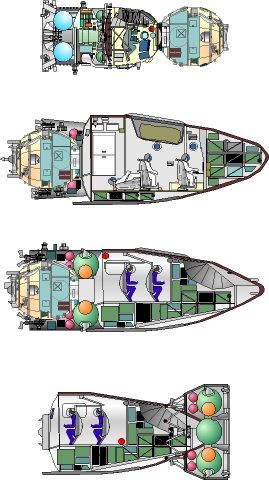 | Kliper Cutaway view of Kliper versions, from top: Soyuz spacecraft which Kliper is to replace; 2005 winged version; 2004 lifting body version; 1990's original concept. Credit: © Mark Wade |
 | Kliper Credit: © Mark Wade |
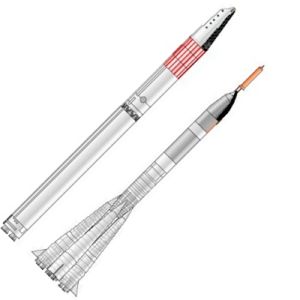 | VKK and Kliper LVs Comparison of Zenit-2/VKK and Onega/Kliper LV/Spacecraft systems Credit: © Mark Wade |
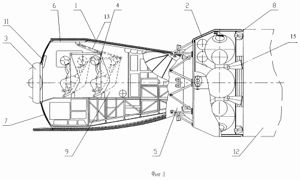 | Kliper Alternate configuration of the Kliper space plane. Drawing from Russian patent RU 2220077, assigned to Semenov, Head of RKK Energia Credit: via Joachim Wienecke |
 | Kliper Prospective Kliper launch vehicles: from left: Angara 3A, Zenit-2SLB, Onega/Soyuz-3 Credit: © Mark Wade |
 | Kliper Kliper lunar orbit mission profile, with landing in Central Asia. Credit: via Ed Grondine |
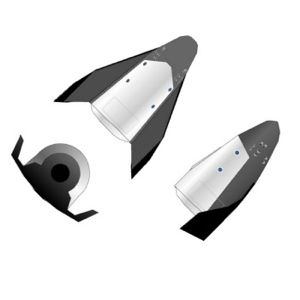 | Kliper Kliper, winged 2005 version, 3-view Credit: © Mark Wade |
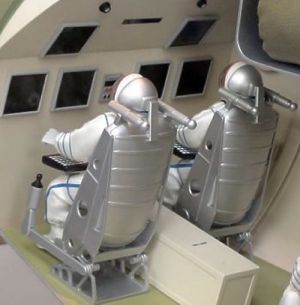 | Kliper Credit: © Dietrich Haeseler |
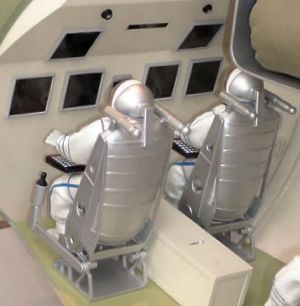 | Kliper Credit: © Dietrich Haeseler |
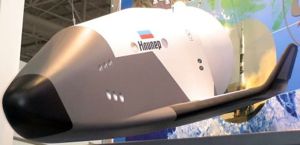 | Kliper Credit: © Dietrich Haeseler |
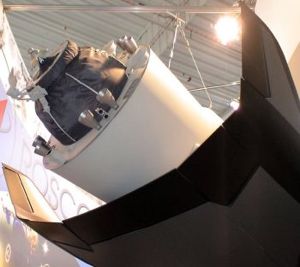 | Kliper Credit: © Dietrich Haeseler |
 | Kliper External view of Kliper versions, from top: 2005 winged version; 2004 lifting body version; 1990's original concept. Credit: © Mark Wade |
 | Kliper interior view of 2006 configuration Credit: Tristan Cools |
 | New Generation Manned Spacecraft Credit: © Mark Wade |
 | New Generation Launch Escape Systems of New Generation Manned Spacecraft Credit: © Mark Wade |
Back to top of page
Home - Search - Browse - Alphabetic Index: 0- 1- 2- 3- 4- 5- 6- 7- 8- 9
A- B- C- D- E- F- G- H- I- J- K- L- M- N- O- P- Q- R- S- T- U- V- W- X- Y- Z
© 1997-2019 Mark Wade - Contact
© / Conditions for Use